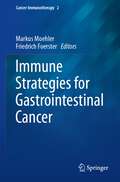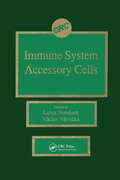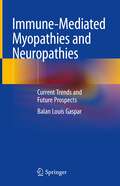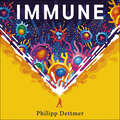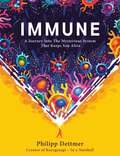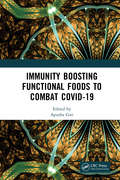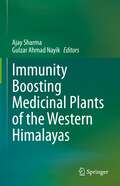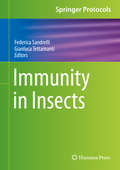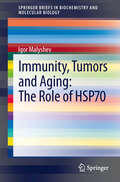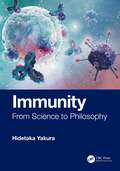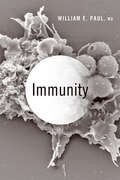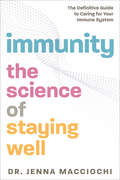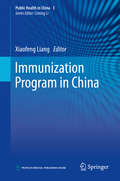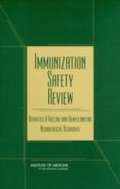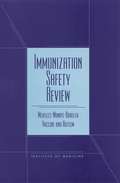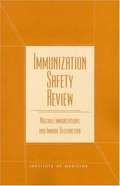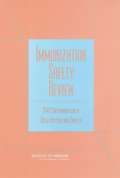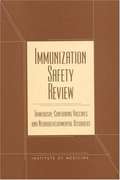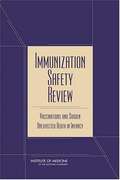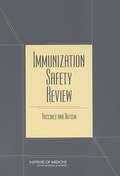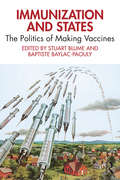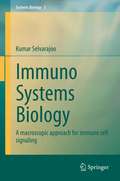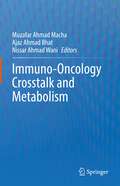- Table View
- List View
Immune Strategies for Gastrointestinal Cancer (Cancer Immunotherapy #2)
by Markus Moehler Friedrich FoersterThis book provides an overview of the available evidence surrounding immunotherapy in gastrointestinal cancers, and discusses its future place in clinical practice.Immunotherapy has celebrated some astonishing therapeutic successes in a variety of cancer types and is becoming increasingly relevant in daily clinical practice. Currently, the predominant class of immunotherapeutic drugs is the so-called checkpoint inhibitors, which disengage the physiological brakes on the immune system, enabling a more effective anti-cancer immune response. Malignancies of the gastrointestinal tract, which account for the majority of cancer cases worldwide, are a major cause of morbidity and mortality, creating an urgent need for more effective therapies. A large number of clinical trials have evaluated the efficacy of cancer immunotherapy in gastrointestinal malignancies and demonstrated its potential in certain subsets of patients. This book will appeal to a wide readership, including oncologists, health care professionals in general and biomedical scientists.
Immune System Accessory Cells
by Vaclav Vetvicka Lubor FornusekImmune System Accessory Cells provides a comprehensive survey of all types of antigen-presenting and accessory cells. Macrophages are emphasized through descriptions of different types of endocytosis, other major properties, and all basic and new information concerning macrophages as antigen-presenting cells. Other topics covered include the impact of the immunodeficient state on accessory functions, the evolutionary emergence of accessory functions, and the role of various cell types in defense reactions in major assemblages of Metazoa. The book also presents a chapter describing the phylogenetic aspects of accessory functions, which traces the first accessory cells during the evolution of living matter.Immune System Accessory Cells is an excellent reference for immunologists, cell biologists, and others interested in developing an understanding of the roles of accessory cells in all facets of immune reactions.
Immune-Mediated Myopathies and Neuropathies: Current Trends and Future Prospects
by Balan Louis GasparThe book covers all aspects of immune-mediated diseases of the muscle and nerve, which are a group of complex diseases, whose diagnosis needs a team of specialists in the field of neuropathology, immunopathology, neurology, and rheumatology. Nerve and muscle biopsy evaluation is invaluable in distinguishing immune-mediated from etiologies and therefore, despite being invasive, pathological evaluation of nerve and muscle has stood the test of time. Chapters cover all the essential aspects of each disease entity viz. the pathogenesis, clinical features, diagnostic armamentarium, and guidelines for diagnosis and management. It is supplemented with full-colorful illustrations and photomicrographs for better comprehension. It includes a chapter highlighting the current progress in the field of immune-mediated myopathies and neuropathies as it is a rapidly evolving field with the addition of many new entities.This clinically oriented book serves as a primer for general histopathologists as well as a practice guide for neuropathologists. It is also relevant for neurologists and rheumatologists and encourages young medical students, residents, and research scholars in the field of neuropathology, neurology, and rheumatology to get involved in active research.
Immune: The new book from Kurzgesagt - a deep dive into the immune system
by Philipp DettmerA deep dive into the immune system that will forever change how you think about your body - how it works and why it is both your greatest ally and most dangerous enemy - from the creator of the popular science YouTube channel Kurzgesagt - In a Nutshell.'A truly brilliant introduction to the human body's vast system for fighting infections and other threats'JOHN GREEN, #1 New York Times bestselling author of The Fault in Our Stars'Reads as if it's a riveting sci-fi novel . . . a delightful treat for the curious'TIM URBAN, creator of Wait But Why**************You wake up and feel a tickle in your throat. Your head hurts. You're mildly annoyed as you get the kids ready for school and dress for work yourself. Meanwhile, an utterly epic war is being fought, just below your skin. Millions are fighting and dying for you to be able to complain as you drink your cup of tea and head out the door.So what, exactly, IS your immune system?Second only to the human brain in its complexity, it is one of the oldest and most critical facets of life on Earth. Without it, you would die within days. In Immune, Philipp Dettmer, the brains behind the most popular science channel on YouTube, takes listeners on a journey through the fortress of the human body and its defences. There is a constant battle of staggering scale raging within us, full of stories of invasion, strategy, defeat, and noble self-sacrifice. In fact, in the time you've been listening to this, your immune system has probably identified and eradicated a cancer cell that started to grow in your body.Each chapter delves deeply into an element of the immune system, including defences like antibodies and inflammation as well as threats like viruses, bacteria, allergies and cancer, as Dettmer reveals why boosting your immune system is actually nonsense, how parasites sneak their way past your body's defences, how viruses - including the coronavirus - work, and what goes on in your wounds when you cut yourself.Enlivened by immersive descriptions, Immune turns one of the most intricate, interconnected, and confusing subjects - immunology - into a gripping adventure through an astonishing alien landscape.Challenging what you know and think about your own body and how it defends you against all sorts of maladies and how it might also eventually be your own downfall, Immune is a vital and remarkably fun crash course in what is arguably, and increasingly, the most important system in the body.(P) 2021 Hodder & Stoughton Limited
Immune: The new book from Kurzgesagt - a gorgeously illustrated deep dive into the immune system
by Philipp Dettmer__________Pre-order now: The first book from the creator of the wildly popular science YouTube channel, Kurzgesagt - In a Nutshell, a gorgeously illustrated deep dive into the immune system that will change how you think about your body forever. 'A truly brilliant introduction to the human body's vast system for fighting infections and other threats'JOHN GREEN, #1 New York Times bestselling author of The Fault in Our Stars'Reads as if it's a riveting sci-fi novel . . . a delightful treat for the curious'TIM URBAN, creator of Wait But Why__________You wake up and feel a tickle in your throat. Your head hurts. You're mildly annoyed as you get the kids ready for school and dress for work yourself. Meanwhile, an utterly epic war is being fought, just below your skin. Millions are fighting and dying for you to be able to complain as you drink your cup of tea and head out the door.So what, exactly, IS your immune system?Second only to the human brain in its complexity, it is one of the oldest and most critical facets of life on Earth. Without it, you would die within days. In Immune, Philipp Dettmer, the brains behind the most popular science channel on YouTube, takes readers on a journey through the fortress of the human body and its defences. There is a constant battle of staggering scale raging within us, full of stories of invasion, strategy, defeat, and noble self-sacrifice. In fact, in the time you've been reading this, your immune system has probably identified and eradicated a cancer cell that started to grow in your body.Each chapter delves deeply into an element of the immune system, including defences like antibodies and inflammation as well as threats like viruses, bacteria, allergies and cancer, as Dettmer reveals why boosting your immune system is actually nonsense, how parasites sneak their way past your body's defences, how viruses - including the coronavirus - work, and what goes on in your wounds when you cut yourself.Enlivened by engaging full-colour graphics and immersive descriptions, Immune turns one of the most intricate, interconnected, and confusing subjects - immunology - into a gripping adventure through an astonishing alien landscape.Challenging what you know and think about your own body and how it defends you against all sorts of maladies and how it might also eventually be your own downfall, Immune is a vital and remarkably fun crash course in what is arguably, and increasingly, the most important system in the body.__________
Immunitary Life: A Biopolitics of Immunity
by Nik BrownThis book explores the growing intellectual interest in the politics of immunity. It argues that taking an ‘immunitary perspective’ is necessary if we are to better appreciate the body as a site of politics in the contemporary age. It explores the dynamic tensions between community and immunity, belonging and fragmentation, the social and the individual. It creates a dialogue between the social sciences, humanities and biopolitical philosophy around immunity. Immunitary Life empirically situates immunitary politics in real-world debates. This includes blood donation and evolving notions of embodied intimacy in the worlds of transplantation. It examines changing ideas about infectivity, bugs, and the emergence of ‘resistance’ in antibiotics. The politics of vaccination offers a classic context for thinking about the ever changing relationships between the communal and the individual. Immunitary Life is essential reading for contemporary scholarship in the sociology of the body and the political philosophy of biomedicine.
Immunity Boosting Functional Foods to Combat COVID-19
by Apurba GiriIn this book, several functional foods or food ingredients, their mechanism of immune enhancing properties and use in food products have been discussed through seventeen chapters written by eminent authors. There are several medicinal plants which have significant role for immunity boosting such as Ashwagandha, Tulsi, Shatavari, Giloy, Aloe vera, Amla, Neem, licorice, garlic, ginger, turmeric, rosemary, black cumin, cinnamon, sage, thyme,fenugreek, peppermint, black pepper, clove etc. These have been discussed in detail.Note: T&F does not sell or distribute the hardback in India, Pakistan, Nepal, Bhutan, Bangladesh and Sri Lanka.
Immunity Boosting Medicinal Plants of the Western Himalayas
by Ajay Sharma Gulzar Ahmad NayikThis book presents a comprehensive guide to traditional immunity-boosting medicinal plants of the Himalayas, their traditional uses, phytochemistry, pharmacology, diversity, conversation, biotechnology, toxicology, as well as future prospective. All the chapters cover the latest advances in ethnobotany, phytochemistry, biochemistry, and biotechnology. The book offers a valuable asset for researchers and graduate students of chemistry, botany, biotechnology, microbiology, and the pharmaceutical sciences. The main purpose of the present book is to draw on the rich culture, folklore, and biodiversity of immunity-boosting medicinal plants of the Western Himalayas, with particular emphasis on the Indian Trans-Himalayan and Western Himalayan region. All the plants included in the present book are extensively used by the local tribes and people for their health-promoting properties from ancient times. This book will be a substantial contribution to the knowledge of the region and the country. Also, the book will be very useful to scientists, graduates, and undergraduates, along with researchers in the fields of natural products, herbal medicines, ethnobotany, pharmacology, chemistry, and biology. Further, it is an equally significant resource for a person working in different traditional medicinal systems; doctors (especially those engaged in Ayurveda, Chinese traditional medicinal system, Amchi, and allopathy); the pharmaceutical industry (for drug design and synthesis); biochemistry and biotechnology sciences; and the agricultural sciences.
Immunity in Insects (Springer Protocols Handbooks)
by Federica Sandrelli Gianluca TettamantiThis volume details methods and protocols necessary to further the study of insect immunity. Chapters guide readers through up-to-date genomic and transcriptomic approaches, insect samples for proteomic analysis, hemocytes in Drosophila, cellular response in Lepidoptera, insect AMPs, manipulate the composition of mosquito microbiota, viral infections in insects, infections by entomopathogenic nematodes, immune response following oral infections, and protocols to to monitor the effect of septic infections with human pathogens using B. mori as a model. Written in the highly successful Methods in Molecular Biology series format, chapters include introductions to their respective topics, lists of the necessary materials and reagents, step-by-step, readily reproducible laboratory protocols, and tips on troubleshooting and avoiding known pitfalls. Authoritative and cutting-edge, Immunity in Insects aims to ensure successful results in the further study of this vital field.
Immunity, Tumors and Aging: The Role of HSP70
by Igor MalyshevThe book is dedicated to the topical area of biology and medicine and the role of stress proteins HSP70 in the regulation of intracellular protein homeostasis, signaling transduction and cell protection. The book is divided into chapters, which describe the discovery of HSP70 and its molecular structure, the mechanism of the synthesis and function in normal and damaged cells, examine the role of HSP70 in immunity, cancerogenesis, aging, Alzheimer's disease and cardiac surgery. In this book, the author looks at HSP70 as a factor which prevents the transformation of homeostasis mechanisms of intracellular proteins into a link in the pathogenesis of a disease.
Immunity: From Science to Philosophy
by Hidetaka YakuraThis book explores the essence of immunity. After an initial review of hypotheses, models, and theories proposed to explain immune phenomena in humans and mice, it summarizes the results from synchronic organism‑level analyses and diachronic analyses tracing phylogeny. These results suggest that immunity is coextensive with life and is equipped with functions similar to the nervous system. Philosophical reflection with reference to Spinoza and Canguilhem suggests immunity is part of the essence of life—and the essence of immunity embraces mental elements with normativity. Approaching the essence of any phenomenon in this way is called "metaphysicalization of science." This book demonstrates the potential of this approach and contributes to a richer understanding of nature.Key Features Reviews the history of immunological theories Discusses and integrates science and philosophy Provides a biological framework for cognition and self vs. nonself Inspired by Auguste Comte’s "The Law of Three Stages"
Immunity: How Elie Metchnikoff Changed the Course of Modern Medicine
by Luba VikhanskiAround Christmas of 1882, while peering through a microscope at starfish larvae in which he had inserted tiny thorns, Russian zoologist Elie Metchnikoff had a brilliant insight: what if the mobile cells he saw gathering around the thorns were the same as white blood cells that traveled to the site of an injury or infection in a human or other animal? Was this some form of cellular defense? Metchnikoff's theory of immunity, that phagocytes--white blood cells--formed the first line of defense against invading bacteria would eventually earn the scientist the unofficial moniker "Father of Natural Immunity" and a Nobel Prize. But first, he had to convince his colleagues, including the skeptical Robert Koch. Author Luba Vikhanski chronicles Metchnikoff's remarkable life, work, and discoveries in Immunity, the first modern biography of this hero of medicine. Metchnikoff was a towering figure in the scientific community of the early 20th century, a tireless humanitarian who worked to curb cholera, syphilis, and other diseases, and pioneered research into probiotics and gerontology. Though Metchnikoff is largely forgotten today, Vikhanski makes a compelling case that his work on natural immunity is finally receiving the attention it deserves.
Immunity: Innate Immunity (Advances In Experimental Medicine And Biology Ser. #560)
by William E. PaulA leading figure in immunology takes readers inside the remarkably powerful human immune system.Winner of the CHOICE Outstanding Academic Title of the Choice ACRLThe immune system has incredible power to protect us from the ravages of infection. Boosted by vaccines, it can protect us from diseases such as measles. However, the power of the immune system is a double-edged sword: an overactive immune system can wreak havoc, destroying normal tissue and causing diseases such as type I diabetes, rheumatoid arthritis, and multiple sclerosis. The consequences of an impaired immune system, on the other hand, are all too evident in the agonies of AIDS.Packed with illustrations, stories from Dr. William E. Paul’s distinguished career, and fascinating accounts of scientific discovery, Immunity presents the three laws of the human immune system—universality, tolerance, and appropriateness—and explains how the system both protects and harms us. From the tale of how smallpox was overcome and the lessons of the Ebola epidemic to the hope that the immune system can be used to treat or prevent cancer, Dr. Paul argues that we must take advantage of cutting-edge technologies and promising new tools in immunological research.
Immunity: The Science of Staying Well—The Definitive Guide to Caring for Your Immune System
by Dr. Jenna Macciochi“A highly accessible resource for those interested in ways to improve their overall health by improving the health of their immune system.” —ChoiceThe immune system is your constant guardian, fighting around the clock to protect you from disease. There’s a lot you can do to strengthen this first line of defense against all kinds of threats, from COVID-19 to cancer. In this book, immunologist Dr. Jenna Macciochi gives us a crash course on how the immune system actually works—and how to keep yours in shape—with authoritative guidance on: ·the best foods to eat to strengthen your immune system ·the importance of movement, and how often to exercise ·the essential link between immunity and sleep ·the immune system’s surprising connection to your mental health, and more
Immunization Program in China (Public Health in China #3)
by Xiaofeng LiangThis book aims to describe the achievements, policy and system of immunization management in China during the last 60 years. Immunization is one of the most effective and cost-effective means to prevent infectious diseases. The Chinese government has long attached great importance to immunization, and with several generations of effort, China has made great achievements through its immunization program.The book consists of 9 chapters, including the introduction of vaccination and immunization policy, immunization services, innovative vaccines, immunization activities in China. The book also demonstrates some of the hardships and difficulties behind the immunization achievements, and introduces the effort of Expanded Program of Immunization (EPI) staff and the support and assistance from the international community.
Immunization Safety Review: Hepatitis B Vaccine And Demyelinating Neurological Disorders
by Immunization Safety Review CommitteeThe National Academies Press (NAP)--publisher for the National Academies--publishes more than 200 books a year offering the most authoritative views, definitive information, and groundbreaking recommendations on a wide range of topics in science, engineering, and health. Our books are unique in that they are authored by the nation's leading experts in every scientific field.
Immunization Safety Review: Measles-mumps-rubella Vaccine And Autism
by Immunization Safety Review CommitteeThe National Academies Press (NAP)--publisher for the National Academies--publishes more than 200 books a year offering the most authoritative views, definitive information, and groundbreaking recommendations on a wide range of topics in science, engineering, and health. Our books are unique in that they are authored by the nation's leading experts in every scientific field.
Immunization Safety Review: Multiple Immunizations And Immune Dysfunction
by Immunization Safety Review CommitteeThis brief report examines the possibility that multiple immunizations during infancy increase the possibility of immune dysfunction. Specifically, it considers evidence related to biological mechanisms and epidemiological factors linking immunizations to infection, autoimmune disease type 1 diabetes, and allergies. There is no index. Annotation (c)2003 Book News, Inc. , Portland, OR (booknews. com)
Immunization Safety Review: Sv40 Contamination Of Polio Vaccine And Cancer
by Immunization Safety Review CommitteeInformation on the Immunization Safety Review
Immunization Safety Review: Thimerosal-containing Vaccines And Neurodevelopmental Disorders
by Institute of MedicienInformation on Thimerosal-containing Vaccines And Neurodevelopmental Disorders
Immunization Safety Review: Vaccinations And Sudden Unexpected Death In Infancy
by Institute of Medicine of the National AcademiesWith current recommendations calling for infants to receive multiple doses of vaccines during their first year of life and with sudden infant death syndrome (SIDS) the most frequent cause of death during the postneonatal period, it is important to respond to concerns that vaccination might play a role in sudden unexpected infant death. The committee reviewed epidemiologic evidence focusing on three outcomes: SIDS, all SUDI (sudden unexpected death in infancy), and neonatal death (infant death, whether sudden or not, during the first 4 weeks of life). Based on this review, the committee concluded that the evidence favors rejection of a causal relationship between some vaccines and SIDS; and that the evidence is inadequate to accept or reject a causal relationship between other vaccines and SIDS, SUDI, or neonatal death. The evidence regarding biological mechanisms is essentially theoretical, reflecting in large measure the lack of knowledge concerning the pathogenesis of SIDS.
Immunization Safety Review: Vaccines And Autism
by Institute of Medicine of the National AcademiesThis eighth and final report of the Immunization Safety Review Committee examines the hypothesis that vaccines, specifically the measles-mumps-rubella (MMR) vaccine and thimerosal-containing vaccines, are causally associated with autism. The committee reviewed the extant published and unpublished epidemiological studies regarding causality and studies of potential biologic mechanisms by which these immunizations might cause autism. Immunization Safety Review: Vaccines and Autismfinds that the body of epidemiological evidence favors rejection of a causal relationship between thimerosal-containing vaccines and autism. The book further finds that potential biological mechanisms for vaccine-induced autism that have been generated to date are only theoretical. It recommends a public health response that fully supports an array of vaccine safety activities and recommends that available funding for autism research be channeled to the most promising areas. The book makes additional recommendations regarding surveillance and epidemiological research, clinical studies, and communication related to these vaccine safety concerns.
Immunization and States: The Politics of Making Vaccines
by Stuart BlumeGlobally, there has been a move away from national public sector vaccine development over the past 30 years. Immunization and States: The Politics of Making Vaccines explores vaccine geopolitics, analyzing why, and how this move happened, before looking at the ramifications in the context of Covid-19. This unique book uses eight country studies – looking at Croatia, India, Iran, the Netherlands, Romania, Serbia, Spain, and Sweden – to explore the role of public sector vaccine institutes, past and present. Raising questions about national sovereignty, the erosion of multilateralism, and geopolitics, it also contributes to debates around public interest and privatization in the health sector. An extended introduction sets the chapters in an international context, whilst the epilogue looks forward to the future of vaccine development and production. This is an important book for students, scholars, and practitioners with an interest in vaccine development from a range of fields, including public health, medicine, science and technology studies, history of medicine, politics, international relations, and the sociology of health and illness.
Immuno Systems Biology
by Kumar SelvarajooImmuno Systems Biology aims to study the immune system in the more integrated manner on how cells and molecules participate at different system levels to the immune function. Through this book Kumar Selvarajoo introduces to physicists, chemists, computer scientists, biologists and immunologists the idea of an integrated approach to the understanding of mammalian immune system. Geared towards a researcher with limited immunological and computational analytical experience, the book provides a broad overview to the subject and some instruction in basic computational, theoretical and experimental approaches. The book links complex immunological processes with computational analysis and emphasizes the importance of immunology to the mammalian system.
Immuno-Oncology Crosstalk and Metabolism
by Muzafar Ahmad Macha Ajaz Ahmad Bhat Nissar Ahmad WaniThis book discusses the novel metabolic cross-talk between immune and tumor cells in the tumor microenvironment that promotes their growth and progression. It also describes deregulated metabolism in cancer cells that promotes suppressive and cancer cell-favourable microenvironment. Further, the book provides novel insights on the metabolic changes in immune cells that promote tumor cell growth and survival. In turn, it also reviews the involvement of immuno-onco metabolic cross-talk in the development of resistance to chemo-radiation therapy (CRT) in tumor cells. Lastly, it also explores the potential of immuno-oncology metabolism as a therapeutic approach against tumor cells.
